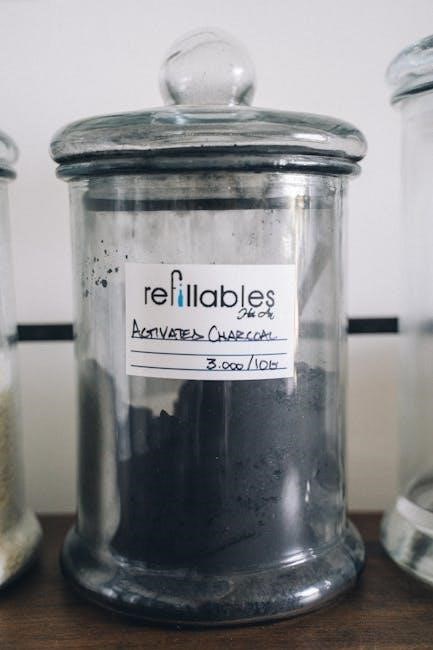Understanding UN3481 Labels
UN3481 labels identify packages containing lithium-ion batteries, classified as hazardous materials․ These labels ensure proper handling during shipping, alerting personnel to potential risks associated with lithium-ion batteries․ Correct labeling is crucial for compliance with transport regulations․
What is a UN3481 Label?
A UN3481 label is a hazard communication tool specifically designed for packages containing lithium-ion batteries․ These batteries are classified as dangerous goods due to their potential to cause fires or explosions if not handled correctly․ The label serves as a visual warning to handlers and carriers, indicating the presence of these potentially hazardous materials․ It’s a critical element in ensuring the safe transport of lithium-ion batteries by providing essential information about the contents of the package․ This label helps ensure that all personnel involved in the shipping process are aware of the specific risks associated with the package contents, enabling them to take appropriate precautions․
Importance of UN3481 Labels
UN3481 labels are crucial for safely shipping lithium-ion batteries․ They alert handlers to potential hazards, ensuring proper handling and preventing accidents during transportation․ Compliance with regulations minimizes risks and promotes safer shipping practices․
Why are UN3481 Labels Necessary?
UN3481 labels are essential because they communicate the presence of potentially hazardous lithium-ion batteries within a package․ These batteries can pose fire or explosion risks if mishandled․ The labels provide crucial information to handlers and carriers, enabling them to take necessary precautions․ These precautions include following specific handling procedures and adhering to regulatory requirements․ Proper labeling reduces the likelihood of accidents, ensures compliance with shipping regulations, and safeguards the transportation process for everyone involved by clearly indicating the contents․

Key Information on a UN3481 Label
A UN3481 label must display the UN number, proper shipping name (“Lithium Ion Batteries”), and a hazard class․ It may also need a contact phone number and specific handling instructions, ensuring safe transit․
Required Elements on the Label
The UN3481 label necessitates several key elements for compliance and safety․ Primarily, the UN number “UN3481” itself must be prominently displayed․ The proper shipping name, typically “Lithium Ion Batteries,” is essential for identification․ Inclusion of the hazard class is also a mandate․ Furthermore, a phone number for additional information is often required․ The lithium battery mark and cargo aircraft only label may be needed․ Remember that the Class 9 must be included in the bottom part of the Lithium Battery Class 9 label․ These details ensure proper handling and communication throughout the shipping process․
Sources for Free Printable UN3481 Labels in PDF Format
Reliable sources for free printable UN3481 labels in PDF format can be found on websites specializing in transportation safety and regulatory compliance․ Ensure the templates are up-to-date and compliant with IATA regulations before use․
Where to Find Reliable Templates
Finding reliable UN3481 label templates requires diligence․ Begin by checking official sources like IATA’s website or regulatory agencies focused on hazardous materials transportation․ These entities often provide compliant templates or links to approved providers․ Look for templates that clearly display all required elements, including the UN number and hazard class․ Ensure the source is reputable and the template is up-to-date with current regulations․ Verify that the PDF format is high-resolution for clear printing․ Consider cross-referencing templates from multiple sources to confirm accuracy and completeness before use for shipping․ Always prioritize safety and regulatory compliance․
Label Dimensions and Specifications
UN3481 labels must adhere to specific size requirements, often 120mm x 110mm, as specified by IATA․ These dimensions ensure visibility and standardization․ Accurate adherence to these specifications is crucial for compliance and safety during shipping․
IATA Requirements for UN3481 Labels
IATA regulations mandate specific requirements for UN3481 labels used in air transport․ The label must include the UN number, and a phone number for information․ The Class 9 hazard symbol is essential, with a red frame․ No other text besides Class 9 is allowed at the bottom․ Correct dimensions, such as 120mm length x 110mm height, are critical․ Compliance with IATA standards ensures safe handling and transport of lithium-ion batteries․ The shipper is responsible for accurate label completion and placement․ Deviation from these requirements can result in shipment rejection or penalties․ Utilizing reliable PDF templates helps maintain compliance․

Customization of UN3481 Labels
UN3481 label templates are customizable to meet specific shipping needs․ Users can add phone numbers or company logos, while ensuring compliance․ PDF and Word formats allow for easy editing, maintaining vital information accuracy․
Using Templates for Specific Needs
Utilizing UN3481 label templates is essential for adapting to diverse shipping requirements․ Templates, often available in PDF or Word formats, are customizable․ Users can modify these to include specific details like contact information or extra warnings․ Ensuring the template is from a reliable source guarantees accuracy․ These templates facilitate compliance with regulations, reducing the risk of shipping errors․ Proper customization ensures that vital information is clearly displayed, promoting safety and adherence; Tailoring labels to precise needs streamlines operations and minimizes potential hazards associated with lithium-ion battery shipments․ This adaptability is crucial for businesses handling varying quantities and types of batteries․
Printing UN3481 Labels
Printing UN3481 labels requires attention to detail․ Ensure labels are printed to scale and in color, with a red frame․ Using high-quality printers and materials guarantees legibility and durability for proper hazard communication during shipping․
Ensuring Quality and Compliance
To ensure quality and compliance when printing UN3481 labels, it is imperative to utilize reliable templates and sources․ Verify that the chosen PDF accurately reflects current IATA regulations and includes all necessary elements, such as the UN number and hazard class․ Print labels in color, precisely to scale, with a clearly defined red frame․ Employ durable, weather-resistant materials to withstand shipping conditions․ Regularly review label integrity for legibility․ Consistent adherence to these guidelines mitigates the risk of non-compliance, promoting safety and regulatory adherence throughout transportation processes․ Always double-check against current regulations before shipping․

Shipping Requirements for UN3481 Lithium Ion Batteries
Shipping lithium-ion batteries under UN3481 requires strict adherence to IATA regulations․ Correct packaging, marking, and labeling are crucial․ Proper documentation and declaration are also essential for compliance and safe transportation of these hazardous materials․
Following IATA Regulations
Shipping UN3481 lithium-ion batteries demands strict compliance with IATA regulations․ These regulations cover packaging, labeling, and documentation․ Shippers must accurately declare the battery type and quantity․ Packaging must meet specific standards to prevent damage during transit․ Labels must be clear and correctly placed, including the UN3481 designation․
Proper markings, including the shipper’s and receiver’s information, are mandatory․ Adhering to IATA guidelines ensures the safe and legal transport of lithium-ion batteries, minimizing risks and avoiding penalties․ Staying updated with the latest IATA revisions is also critical for continued compliance․

Consequences of Non-Compliance
Incorrect labeling of UN3481 lithium-ion batteries can lead to severe consequences․ These include fines, shipment delays, and potential legal liabilities․ In worst-case scenarios, it can result in accidents, causing damage, injury, or environmental harm, highlighting compliance importance․
Risks of Incorrect Labeling
Incorrect labeling of shipments containing lithium-ion batteries, identified by UN3481, poses significant risks․ Without proper hazard communication through accurate labels, personnel handling these packages may be unaware of the potential dangers․ This lack of awareness can lead to improper handling, increasing the risk of battery damage, thermal runaway, and fires․ Furthermore, incorrect labeling violates IATA regulations, resulting in fines, delays, and potential rejection of the shipment․ Damaged batteries can cause explosions or release hazardous materials, endangering transportation workers and the environment․ Accurate UN3481 labels are crucial for preventing accidents and ensuring regulatory compliance, thereby mitigating these risks and promoting safety․




Leave a Reply
You must be logged in to post a comment.